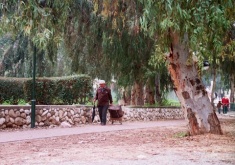
At first, it was literally surreal. Engrossed in work and not being accustomed to listening for the alert, it was just background noise at first. Only after I noticed commotion from the people around me did it come to my attention, and by then, it was too late. I heard it land only seconds after looking up from my computer. Thankfully, it landed somewhere off in the distance.
“Did you hear the Tzeva Adom?” somebody asked. “That was a rocket. We don’t have a shelter, so we just stay inside.”
Somewhat shocked, I hardly acknowledged the question.
A few seconds later, I’d almost relaxed, relieved after surviving my fist Qassam, when the alert sounded again. Neither the alarm nor the rocket seemed off in the distance this time. As I leered out the window, people who had just attempted to return to their daily activities were running right back to the shelters (which looked more like car ports) across the street by the strip mall.
The ground shook as the rocket hit in the middle of the road about ten minutes down the street from the office. Yes, those rockets that look small when police extract them from the road or the rubble and have people asking, what is the big deal when the rockets rarely score a hit, make the earth shake even several miles away from the landing site.
An ambulance had been forced to stop en-route to the site of the first rocket hit, and only after several minutes of calm could they resume their work.
This may come as a surprise to many, but that is not the lasting impression I have of Sderot.
I’ve heard Sderot referred to as, among other things, a border town, a desert outpost, and increasingly, a war zone. I cannot say that any of those descriptions is wrong at this point, but having visited Sderot just once and visited countless towns in the U.S. that have been and always will be bona fide border towns and desert outposts, I can say with conviction that Sderot should be much more.
There is more to Sderot than the rocket attacks and half-demolished houses that the media shows people on TV and in pictures in magazines and newspapers. Upon first arriving in Sderot, I thought I’d been misled. It was not the scene of poverty, plague, death and destruction that I had been brought up believing was the case in combat zones, but a seemingly normal small city that could just as easily be situated 20 minutes outside of Yerushalaim rather than a kilometer east of the Gaza Strip. Schools, shops, restaurants, bars, parks… All the staples of modern civilization exist in Sderot and should be the building blocks for development in an area of Israel the country has always dreamed would one day prosper.
Yet, the residents of Sderot are forced to live their lives amidst a situation generally reserved for residents of third world countries: forgotten and abandoned – left to the wolves, as some would say.
At the same time, though, they continue to live. Parents take their kids to school, the children learn, adults go to work, just like everybody else. In my opinion, reports of Sderot’s demise have been exaggerated. It is in critical condition but it can still pull through if it has a reason to want life, which is why people cannot abandon the city or its people.












